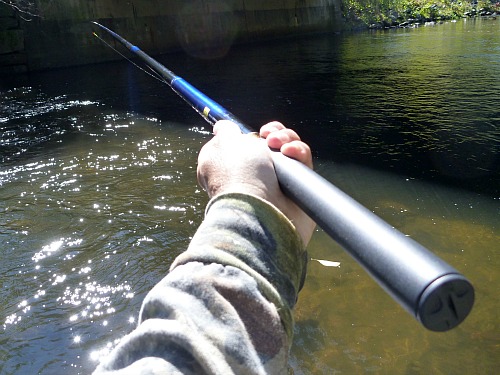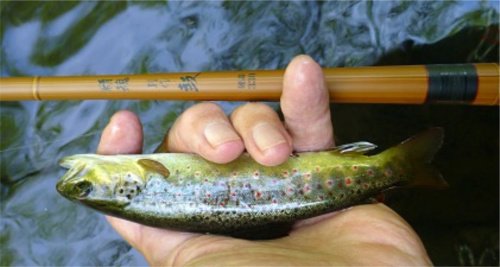Upstream Worm Rods
The development that again makes the
upstream worm as effective as it once was is the availability of tenkara, seiryu
and keiryu rods. Tenkara rods, designed for fishing
artificial flies without added weight, and keiryu rods, designed for
fishing live bait with split shot, both provide what is needed to fish
the upstream worm effectively: a long, pliant rod. Seiryu rods, designed for fishing small, placid streams for smaller fish with bait or flies, work very well indeed.
The old masters recommended fishing the upstream worm with rods ranging from 12 to 17 feet long - with several recommending the same 12 foot rod the angler used for fly fishing (remember this was 80 to 150 years ago). For the last 50 years, at least, a 9 foot fly rod was the longest that was readily available. Only within the last few years have 10 and 11 foot "Euro-nymphing" rods been available. Only in the past ten years have 12 to 14 foot tenkara rods been available outside of Japan.
While an
11' Euro-nymphing rod would be better at the upstream worm than a
standard 9 foot fly rod, a 12 to 14 foot tenkara rod would be better
yet. For slightly larger streams, a 17 foot keiryu rod would be better
than a tenkara rod. The longer rod allows you to cast the length of line required to be far enough away from the fish that you don't scare them - and to cast the line gently enough that it doesn't tear the worm off the hook. The long rod also allows you to keep your line off the surface of the water.
Finally, we again have rods that are suitable for fishing the upstream worm.

Although the Japanese have rods well suited to fishing the upstream worm, they don't do it. Japanese keiryu anglers do fish with worms, but upstream worm fishing as practiced in 19th century England and Scotland differs enough from keiryu fishing as practiced in Japan that it really is a technique unto itself.
Keiryu fishing is done primarily across
and down rather than upstream. The keiryu line is extremely light. A split shot is added to provide the weight to
make the cast and to get
the bait down near the bottom.
Upstream Worm fishing is by definition done
upstream, with no added weight if the water is not too deep and the current not too
fast. The line itself provides the weight
necessary to make the cast. Initially the line would have been
horsehair.
When I first tried what I called Ultralight Worm Fishing, I was sure tenkara line would allow me to cast a worm. After all, it casts flies without any added weight so it would surely cast a worm without added weight. My biggest concern was whether the casting action would tear the worm off the hook.

I started with my softest seiryu rod. The rod is so soft and the casting motion so slow and gradual that it did not tear the worm off the hook. The weight of the line, plus the weight of the worm itself made casts easy and accurate.
My next question was whether the technique was limited to the softest of rods. Would it be possible to use a firmer rod and still not tear the worm off the hook when starting my forward cast?
I switched to a 12 foot keiryu rod which was much closer to the stiffness of many tenkara rods. By slowing my cast just a bit, concentrating on starting the forward cast slowly and accelerating smoothly, I still got great casts and it never did rip the worm off the hook.
Where the stream opened up a bit I switched to a Suntech GM Suikei Keiryu Special 44 (which has been replaced by the TenkaraBum Traveler 44). The result was the same. Concentrating on making a smooth, jerk-free cast allowed me to cast a worm and not have it come off the hook.
On a subsequent trip I tried the same technique with four two-handed keiryu rods, ranging from 5.3 to 6.6 meters in length. All of them were able to cast a worm using size 2.5 fluorocarbon tenkara line. Each of them, even the very soft Suntech FMX Keiryu ZPRO 53 was quite effective in setting the hook, although as I will cover later in the section on hooks and hooking, setting the hook in this technique, with this gear, is really just a tightening of the line.
Several of the early writers on the upstream worm recommend relatively stiff rods, or at least rods with relatively stiff tips in order to get good hook sets. I am pretty sure they wanted a stiff rod tip because they were using much larger hooks with much larger barbs. If you use a small hook with a micro barb, very little force is required for a hook set. Given also that this technique is one that utilizes no, or at most, minimal weight, the worm will not be very deep so you will not have to pull a lot of line through the water. You will not need a stiff rod.
The shortest rod I have used for the upstream worm was 3.3 meters, a bit over 10 feet. The longest was twice that at 6.6 meters. A rod shorter than 3.3m will force you to fish close enough to where you are standing that you will run a definite risk of spooking all the trout you are trying to catch. For all but the smallest streams, I would suggest a rod of about 12 feet (3.6m) at minimum. Personally, I find 7m rods to be cumbersome, and would not choose a rod longer than the 21'7" Suntech Fine Power 66. Although it is much longer than the longest rod recommended by the old masters, it weighs about half of what their rods weighed.
For upstream worm rods, I would suggest concentrating on 3.6 to 4m tenkara rods or 4.4-5.4m keiryu rods.
Upstream Worm Rods
Upstream Worm Lines and Line Sag
Upstream Worm Hooks and Hooking
“The bitterness of poor quality remains long after the sweetness of low price is forgotten” - Benjamin Franklin
"Be sure in casting, that your fly fall first into the water, for if the line fall first, it scares or frightens the fish..." -
Col. Robert Venables 1662
As age slows my pace, I will become more like the heron.
We've all had situations where seriously chewed up flies kept catching fish after fish after fish. It is no sin to tie flies that come off the vise looking seriously chewed up.
Warning:
The hooks are sharp.
The coffee's hot.
The fish are slippery when wet.
Beware of the Dogma
What's in stock?
Suntech Tenkarakyo 40F Tenkara Rods
Old Geezer's Wide-Eyed Fly Box
Coming Soon
December
Kurenai II AR 30F
Kurenai II AR 33F
Kurenai II AR 39F
Nissin Oni Line size 3
Nissin Oni Line size 3.5
January
Furaibo TF39
Furaibo TF39TA
February
TenkaraBum 33
TenkaraBum 36
TenkaraBum 40
Latest Pages
If you enjoy spin fishing or baitcasting please visit my sister site Finesse-Fishing.com.
Black Friday sale on now. 15% off on all Tenryu spinning and baitcasting rods.


